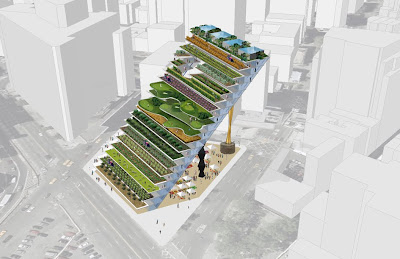Location study from Seeding the City
In considering where to plant vegetable gardens in cities, the considerations are different than for a farm where productivity is the only concern. Instead, it is important to consider the benefits of urban agriculture that extend beyond food production. Urban agriculture is a significant educating force, as many people today are unaware of where their food comes from and the nature of the systems that turn dirt, sun, and water into nourishment.
Accordingly, schools are excellent places for gardens -- the perfect places to leverage garden's educational benefits while also providing fresh fruits and vegetables for the people that need it most: kids.
The edible schoolyard at Berkeley's Martin Luther King Middle School
Perhaps the most famous school vegetable garden can be found in Berkeley at Martin Luther King Jr. middle school. Founded in 1994 with the support of slow food maven Alice Waters, the school's Edible Schoolyard is incorporated into school curriculum, as students not only learn about ecology and natural systems through working in the garden, but also learn about healthy cooking and the benefits of fresh vegetables in cooking classes.
Today, schoolyard gardens are found throughout the bay area and in many cities around the United States. The movement still encounters opposition, however. Indeed, some social observers fail to understand how school gardens add to the educational experience and instead see hands-on work outside as something that comes at the expense other skills, rather that something that complements them. There is much work left to be done to extend more gardens into our schools, both in terms of physically creating space and explaining the benefits to educators at large.
The edible schoolyard at Samuel J. Green charter school, New Orleans, LA.
Economic sustainability is paramount in the efforts of another gardener working in the city: MacArthur genius grant winner Will Allen, at Milwaukee's Growing Power farms. His brilliantly managed operation applies synthesizes lessons from permaculture and community development to generate wellness and economic activity in a struggling corner of the midwestern city.
One of Growing Power's Milwaukee greenhouses
In greenhouses that occupy underutilized land, high-density layered plantings hang above vermiculture systems teeming with composting red worms and aquacultural systems of tilapia and perch. All of these systems interact, the waste of each element fertilizing the growth of another. In the New York Times magazine, author Elizabeth Royte describes how Allen's ingenuity extends beyond the garden:
"He could push his greens into corporate cafeterias, persuade the governor to help finance the construction of an anaerobic digester, wheedle new composting sites from urban landlords, persuade Milwaukee’s school board to buy his produce for its public schools and charm the blind into growing sprouts. (“I was cutting sprouts in the dark one night,” Allen said, “and I realized you don’t need sight to do this.”)"
Growing Power founder Will Allen (From NYTimes)
Ultimately, when studying the urban environments for where to grow, one realizes the only limit is the imagination. From civic centers to highway on-ramps to driveways, people are growing gardens anywhere they can. And so can you!





















